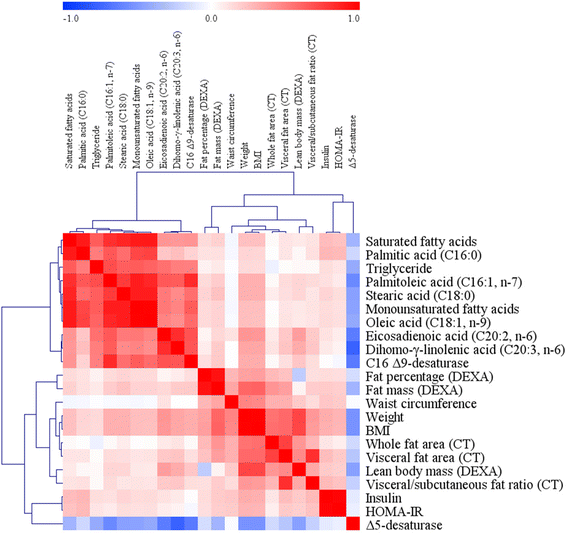Effect of weight loss on circulating fatty acid profiles in overweight subjects with high visceral fat area: a 12-week randomized controlled trial
- PMID: 29471812
- PMCID: PMC5822615
- DOI: 10.1186/s12937-018-0323-4
Effect of weight loss on circulating fatty acid profiles in overweight subjects with high visceral fat area: a 12-week randomized controlled trial
Abstract
Background: Significant associations between visceral fat and alterations in plasma fatty acids have been identified in overweight individuals. However, there are scant data regarding the relationships of the visceral fat area (VFA) with the plasma fatty acid profiles and desaturase activities following weight loss. We investigated the effect of weight loss with mild calorie restriction on the circulating fatty acid profiles and desaturase activities in nondiabetic overweight subjects with high VFA.
Methods: Eighty overweight subjects with high VFA (L4 VFA ≥100 cm2) were randomized into the 12-week mild-calorie-restriction (300 kcal/day) or control groups.
Results: Comparison of the percent of body weight changes between groups revealed that the weight-loss group had greater reductions in body weight. The VFA decreased by 17.7 cm2 from baseline in the weight-loss group (P < 0.001). At follow-up, the weight-loss group showed greater reductions in serum triglycerides, insulin, and HOMA-IR than the control group. Significantly greater reductions in total saturated fatty acids, palmitic acid, stearic acid, total monounsaturated fatty acids, palmitoleic acid, oleic acid, eicosadienoic acid, and dihomo-γ-linolenic acid levels were detected in the weight-loss group compared with the control group after adjusting for baseline values. Following weight loss, C16 Δ9-desaturase activity was significantly decreased and Δ5-desaturase activity was significantly increased, and the changes were greater in the weight-loss group than in the control group.
Conclusions: The results suggest that mild weight loss improves abdominal obesity, overall fatty acid profiles, and desaturase activities; therefore, mild calorie restriction has potential health benefits related to obesity-related diseases in overweight subjects with high VFA.
Trial registration: NCT02992639. Retrospectively registered 11 December 2016.
Keywords: Fatty acid; Fatty acid desaturase; Obesity-related disease; Visceral fat; Weight loss.
Conflict of interest statement
Ethics approval and consent to participate
The purpose of the study was carefully explained to all participants, and written consent was obtained prior to their participation. The protocol was approved by the Institutional Review Board of Yonsei University and Yonsei University Severance Hospital in accordance with the Helsinki Declaration.
Consent for publication
Not applicable
Competing interests
The authors declare that they have no competing interests.
Publisher’s Note
Springer Nature remains neutral with regard to jurisdictional claims in published maps and institutional affiliations.
Figures


References
-
- Katsuki A, Sumida Y, Urakawa H, et al. Increased visceral fat and serum levels of triglyceride are associated with insulin resistance in Japanese metabolically obese, normal weight subjects with normal glucose tolerance. Diabetes Care. 2003;26:2341–2344. doi: 10.2337/diacare.26.8.2341. - DOI - PubMed
Publication types
MeSH terms
Substances
Associated data
Grants and funding
LinkOut - more resources
Full Text Sources
Other Literature Sources
Medical

